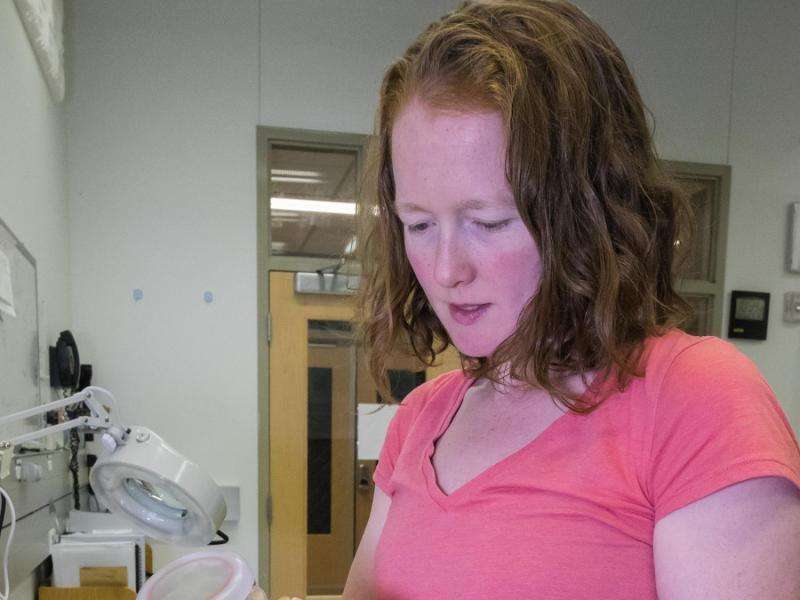NIST develops first widely useful measurement standard for breast cancer MRI

Researchers at the National Institute of Standards and Technology (NIST) have developed the first widely useful standard for magnetic resonance imaging (MRI) of the breast, a method used to identify and monitor breast cancer.
The NIST instrument—a "phantom"—will help standardize MRIs of breast tissue and ensure quality control in comparing images within and between medical research studies. Phantoms mimic the response of human tissue to help test the performance of medical imaging systems. NIST's new breast phantom also can be used to compare MRI scanners and train operators. The phantom supports quantitative MRI, which is increasingly used for breast cancer diagnosis, staging and treatment monitoring as well as for imaging other parts of the body.
As described in a new paper , NIST's prototype breast phantom was tested on MRI systems from two manufacturers in three configurations and produced accurate, quantitative images that could be used to evaluate common imaging procedures. Co-authors of the paper work at the University of California San Francisco where the phantom is already used in clinical trials.
The NIST phantom is widely useful because it fits most major MRI scanner designs and meets a full range of common clinical imaging needs. In addition, like NIST's other MRI phantoms, the breast phantom generates image data that can be traced to international measurement standards. Older breast phantoms don't offer all these capabilities.
The biggest design challenge was to create a lifelike mimic of both fat and fibroglandular tissue, NIST project leader Katy Keenan says. The design success led to industry's rapid commercialization of the phantom, currently used by five research groups.
"I believe the NIST phantom can have a big impact, especially because we are seeing more use of quantitative MRI for breast cancer," Keenan says. "It will be used by both researchers developing new techniques and by radiologists using techniques in the clinic."
The phantom has a flexible, modular design. The soft silicone shell (15 by 12.5 centimeters) enables fitting to different MRI scanners. Internal components are made of rigid polycarbonate to ensure regular geometry. The phantom has two basic types of internal arrangements, which can be paired for MRI scans.
One unit is designed for conventional MRI scans based on magnetic properties of hydrogen atoms. This unit contains four layers of small plastic spheres filled with tissue mimics—corn syrup in water to represent fibroglandular tissue and grapeseed oil to represent fat. The spheres can be customized to meet special clinical needs. Potential future options include solutions that would mimic either benign cysts or tiny bits of calcium called microcalcifications, which can signal cancer.
The second phantom unit is designed for the newer technique of diffusion MRI, which measures the motion of water molecules within the breast. This unit contains plastic tubes filled with varying concentrations of a nontoxic polymer (polyvinylpyrrolidone), similar to NIST's diffusion MRI phantom. The solutions are tuned to mimic the differing diffusion properties of malignant tumors versus benign tumors.
Researchers continue to work on the NIST breast phantom. For instance, natural oils such as grapeseed oil can vary in consistency, so a different fat tissue mimic has been developed, a synthetic oil that remains stable across production batches and over time. In addition, a multi-site trial is planned to examine measurement variations at clinical imaging centers.
More information: K.E. Keenan, A.P. Peskin, L.J. Wilmes, S.O. Aliu, E.F. Jones, W. Li, J. Kornak, D.C. Newitt and N.M. Hylton, "Variability and bias assessment in breast ADC measurement across multiple systems," JMRI, March 23, 2016. DOI: 10.1002/jmri.25237
K.E. Keenan, L.J. Wilmes, S.O. Aliu, D.C. Newitt, E.F. Jones, M.A. Boss, K.F. Stupic, S.E. Russek and N.M. Hylton, "Design of a breast phantom for quantitative MRI," JMRI, March 7, 2016. DOI: 10.1002/jmri.25214




















